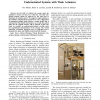Free Online Productivity Tools
i2Speak
i2Symbol
i2OCR
iTex2Img
iWeb2Print
iWeb2Shot
i2Type
iPdf2Split
iPdf2Merge
i2Bopomofo
i2Arabic
i2Style
i2Image
i2PDF
iLatex2Rtf
Sci2ools
CDC
2008
IEEE
2008
IEEE
How springs can help to stabilize motions of underactuated systems with weak actuators
In the field of robotics the energy spent for actuation is always an issue. It is often the case that some desired motions cannot be achieved by the robot due to limitations in actuation power. We suggest a simple solution to the problem: complement the actuators by some configuration of mechanical springs which delivers a torque profile that is well-tuned for the desired robot motion. As a result, the control effort for the original actuator will be reduced. In this case study we consider an underactuated planar two-link robot for experimental demonstration of the concept. The virtual holonomic constraints approach serves as analytical tool to parameterize, plan, and stabilize desired periodic motions.
| Added | 12 Oct 2010 |
| Updated | 12 Oct 2010 |
| Type | Conference |
| Year | 2008 |
| Where | CDC |
| Authors | Uwe Mettin, Pedro X. La Hera, Leonid B. Freidovich, Anton S. Shiriaev |
Comments (0)

